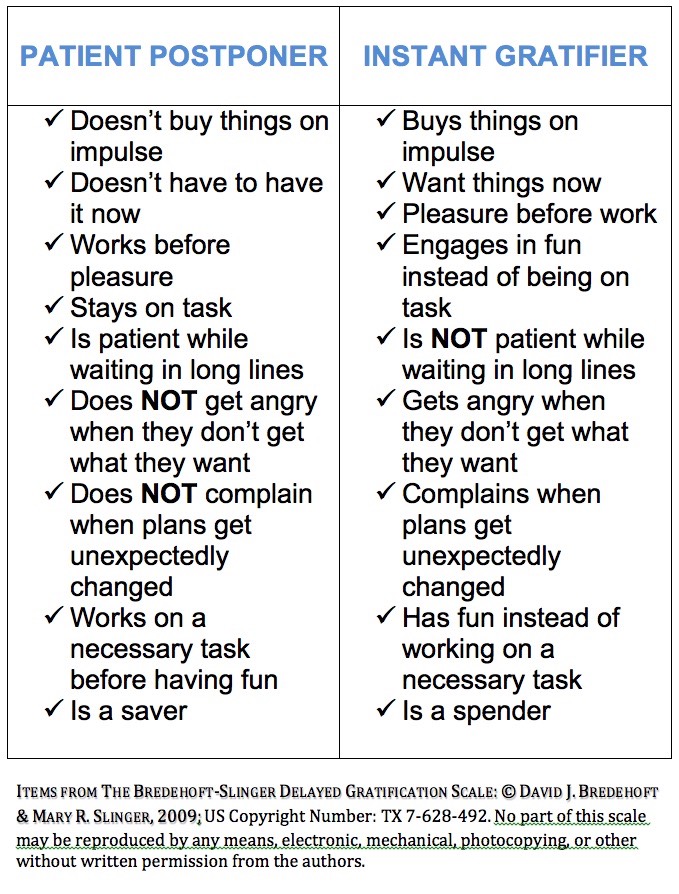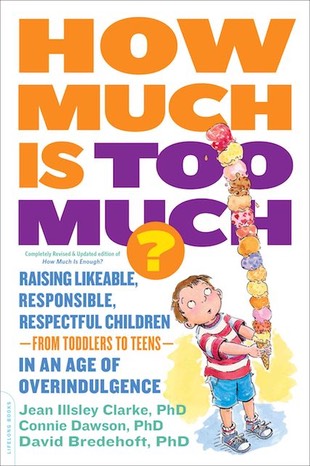
(Click here to download a free pdf copy of this blog)
RAISING CHILDREN WHO RESIST TEMPTATION AND DELAY GRATIFICATION
The challenge is greater today more than ever before to raise children who resist temptation and learn varied strategies to delay gratification. Temptations abound!

Although, according to Walter Mischel, the author of the famed Stanford Marshmallow Experiment; “The good news is that this cognitive and emotional skill set is eminently teachable, particularly early in life. It's great in preschool; it's great within the first few years of life. It's great in adolescence even. And it continues to be a skill set that can be developed even when we’re quite mature adults.”
DO YOU WANT YOUR CHILD TO BE A PATIENT POSTPONER OR AN INSTANT GRATIFIER?

Click here for a related story: Is Your Child An Instant Gratifier or A Patient Postponer?
START TEACHING SELF-CONTROL STRATEGIES EARLY
So, just how do we teach children patience? How do we teach them to resist temptation when they want it right now? How do we teach them self-control?
When I was 10 years old and I wanted a new shiny red bicycle. I thought that the old used one my parents bought me was not good enough. Mom did a wise thing. She told me that I would have to earn it for myself. So, I became a paperboy with the goal of earning enough money to buy a new bike. The next day my father took me to the bank and helped me start my first savings account. Here’s the secret: (1) learning to set an attainable goal, (2) seeing powerful parental models doing the same things, (3) getting encouragement along the way!
10 STRATEGIES THAT TEACH CHILDREN SELF-CONTROL
1. CREATE AN ENVIRONMENT IN WHICH SELF-CONTROL IS CONSISTENTLY REWARDED.
When this happens children develop a sense of trust. Your child trusts that you, the parent, are reliable. This was clearly demonstrated in a remake of the Marshmallow Experiment. Celeste Kidd conducted the experiment just like the original Marshmallow Experiment, except she randomly assigned children to two pre-experiment conditions: (1) unreliable or (2) reliable environment. Next, all of the children were given an art project and promised additional art supplies. In the unreliable condition the adult returned without them and said, “I am sorry, but I made a mistake. We don’t have any other art supplies after all.” In the reliable condition the children got what they were promised. Next, the researcher gave the children a sticker and told them that they could use the sticker now or wait for a larger number of stickers later. In the unreliable condition the adult returned without the stickers as promised and said, “I’m sorry, but I made a mistake. We don’t have andy other stickers after all. But why don’t you just use this one instead?” Immediately after this children were given the marshmallow task.
Guess what. “Children fail the marshmallow task when adults can not be trusted!” (See video below)
2. MODEL SELF-CONTROL FOR YOUR CHILDREN.
The first and probably the most powerful models for children are their parents. We need to not just “Talk the Talk”, we also need to “Walk the Walk”. For instance, I became a saver at an early age by watching my father. Each week he took me to the bank and I watched him put his check into savings. He not only showed me how to do it, he told me what he was doing and why. He told me that he and mom were saving for a car, or saving for our summer vacation. Model self-control for children and talk to them about it. You can model this by saying things like:
“I really want that cookie now, but I am going to wait until after dinner.”
“I really want those new shoes, but I really don’t need them. I’m not going to buy them.”
“This line is really long and we have been waiting for such a long time. I just need to be patient.”
Remember: Children learn what you do!
3. TEACH CHILDREN TO USE DISTRACTIONS.
One basic lesson Walter Mischel learned from the Stanford Marshmallow Experiment was that the four-year-olds who were successful in waiting for the second marshmallow were extremely creative in coming up with ways to distract themselves from the marshmallow that was right in front of them.
A Few Distraction Techniques That Can Be Taught:
ü Counting backwards
ü Change the focus of attention to something else
ü Exercise. Get the body moving
ü Draw pictures using crayons
ü Cleaning your room
For a complete list see: A Mojo Life: Distraction Strategies, and Teaching Your Child Self-Control on Kids Health.
4. DEVELOP AND PRACTICE “IF-THEN’ PLANS
Making “If-then plans and practicing them with children is a specific strategy Walter Mischel researched and found to be highly successful for children who had self-regulating problems. “What you can take from my work… is to use all the strategies I discuss—namely making “if-then” plans and practicing them. Having a whole set of procedures in place can help a child regulate what he is feeling or doing more carefully.”
In each specific situation, I like children to come up with Plan A, Plan B, and Plan C. That way if Plan A doesn’t work they have two additional responses to fall back on. Then, I like to actually practice them by role-playing the situation with them. Try this, it really works!
5. TEACH CHILDREN TO SET ACHIEVABLE GOALS.
For 37 years I was an academic advisor for college students. When one of my advisees failed one or more classes and was on academic probation (at or below 1.75 GPA) I would ask them, “What is your GPA goal for next semester?” Almost every student would say, “I am going to get a 4.0”. My job at that point was to help them set a realistic goal. You see, in 37 years I had never had a student go from a 1.75 to a 4.0 in the next semester.
Me: “Have you ever gotten a 4.0 before?”
Advisee: “No.”
Me: “What was the best semester you have ever had?”
Advisee: “I don’t remember.”
Me: “Let’s take a look at your transcript.”
Advisee: “OK.”
Me: “Two semesters ago you got a 2.1. That was the highest you have scored in college so far.”
Me: “Did you ever make a 4.0 in high school?”
Advisee: “ No, I guess not.”
Me: “I really want you to be successful. One way to do this is to set challenging, but realistic goals. When you reach your goal, you succeed. Then after each success we inch the goal a notch or two higher. NOTHING SUCCEEDS LIKE SUCCESS!
Advisee: “Ok, I get it. Then my goal for next semester is a 2.2. I think I can do that.”
Me: “You think you can do that? Will you say, I know I can make a 2.2.”
Advisee: “I know I can make a 2.2!”
Me: “Great. I would like you to check back with me weekly to report how you are doing.
Advisee: "Ok.”
Me: “But before you go, what is your plan to achieve your 2.2?” (Continue by seeing # 6 below on how to create a plan).
Note: I have used this same strategy successfully with children of all ages. You will need to adjust your language and goals for very young children. Sometimes very young children have difficulty thinking of reasonable goals so you may need to suggest some.
6. HELP CHILDREN TO CREATE A PLAN.
When it comes to setting goals I like the Reality Therapy System. It's very logical and you don’t have to be a therapist to use it. It works by asking a series of questions:
1. “What is it that you want?”
§ Help your child be as specific and he/she can be.
2. “What is it that you are doing to get what you want?”
§ After listening, in a nonjudgemental way list the behaviors he/she is doing
that isn’t working; the behaviors that are not helping your child get what he/she wants.
3. “Is it helping?”
§ The answer to this question is almost always NO. Children tend to do more of the same
even though it's not working. They frequently fail to see the connection between what
they want and what they are doing, and that it is not working.
4. “What’s your new plan to get what you want?”
§ Let children come up with a plan all on their own, but if they can’t give them a plan
that will work.
5. Don’t accept excuses.
§ Children stay stuck in unworkable behaviors when they offer excuses. So, don’t buy
them.
6. Get a commitment to the plan.
§ Get a commitment to the plan by asking:
“What exactly are you going to do?”
“Do you need anything to be successful with your plan?”
“When are you going to start your plan?”
§ Simple
§ Small
§ Something to do, not stop doing
§ Dependent on what your child does, not what others do
§ Specific
§ Repetitive
§ Immediate
7. PRIORITIZE. TEAH CHILDREN TO TACKLE THE MOST IMPORTANT THINGS FIRST.
An important skill that all children can learn is to prioritize. How often do we make lists of things we need to do and then do the things that are fun or that are easy first and put off the hardest, most difficult things for last? We many not even get to the most important things on the list at all! So, help your children to make their own to-do lists and take it one step further by prioritizing the list from the most important to the least important. Teach them to tackle the most important things first.
8. CELEBRATE WHEN A GOAL IS REACHED.
I believe it is important to celebrate when your children atain a goal! Acknowledging success is important, but don’t overdo it. Here are a few suggestions:
üGive them a high five
üFlash them two thumbs up
üLet them pick a fun activity to do
üGive them a sticker
The important thing is that you acknowledge their success!
Click here for a related story: Delayed Gratification in an Age of Overindulgence
9. TEACH CHILDREN TO SAVE MONEY.

if you want your child to become a saver and at the same time learn to be generous and give to others, consider using the Share, Save, Spend formula developed by Nathan Dungan author of Prodigal Sons and Material Girls: How Not to Be Your Child’s ATM. He suggests parents decide a set percentage of EVERY DOLLAR a child earns, receives in gifts, or is given in allowance to be given to charity, saved, and spent. Get three containers. Mark one as Share, one as Save, and one as Spend. Watch the amounts in each grow.
Are you teaching your child how to manage money? Try the following: make a list of what you expect your child's allowance is for. Attach estimated prices and then discuss it with your child. Monitor the process and readjust, discussing money management lessons as they are learned. Recent research found that twice as many children considered themselves to be “spenders” (24%) compared to their parents (12%). Further, 41% were’t knowledge of managing personal finances, 50% didn’t understand credit, and 61% didn’t understand student loan debt. Please talk to your children about money.
10. TEACH POSITIVE SELF-TALK.
Believe in the power of “Self-Talk”. It really does make a difference! If you don’t believe me just try this short demonstration with your child.
1. Have your child hold his arm straight out in front of him. Tell him that you are going to try to push it down to his side. Tell him to resist you and try to prevent you from pushing his arm down to his side. If he is like most children, he does a pretty good job of resisting you.
2. Next, have him repeat the following phrase out loud 10 times: “I am a weak and worthless person.” Tick them off on your fingers as he says the phrase out loud.
3. Repeat #1 above. You will be able to easily push his arm down to his side.
4. I don’t believe in leaving someone weak or worthless, so next have him repeat the following phrase out loud 10 times: “I am a strong and worthy person!” Tick them off on your fingers as he says the phrase out loud.
5. Repeat #1 above. You will have a difficult time pushing his arm down to his side, and with some children, you may not be able to.
This demonstration shows the power of self-talk, both positive and negative. We can teach our children to use positive self-talk to resist temptation and delay gratification. Teach them to use self-talk messages like:
§ I am capable.
§ It’s OK to be patient.
§ It’s OK to wait until I have saved the money to buy it.
§ I choose to get my work done before I play.
§ I choose to think thoughts that serve me well.
§ I am confident.
§ I love challenges and what I learn from overcoming them.
§ Challenges make me stronger.
§ I choose to be patient and not buy it right now.
Say the following phrases out loud 10 times:
üI am a capable parent!
üI am a confident parent!
üI am a patient parent!
üI am a lovable parent!
üI will raise my children to be patient postponers.
There is more help to teach your child to be a “Patient Postponer” in How Much is Too Much? Raising Likeable, Responsible, Respectful Children – From Toddlers To Teens – In An Age of Overindulgence (2014, DaCapo Press Lifelong Books).
Photos by David Bredehoft, quotes on photos by Walter Mischel from The Marshmallow Test: Mastering Self-Control.
Note: some of the concepts expressed in this blog were derived from: 5 Easy Ways To Teach Kids Self-Control and Delayed Gratification by Sarah Ramirez; Teaching Self-Control: Evidence-Based Tips by Gwen Dewar; What the Marshmallow Test Really Teaches About Self-Control by Jacoba Urist; The Marshmallow Test: Mastering Self-Control by Walter Mischel; 14 Mantras To Hel You Build Positive Self-Talk by Belinda Anderson.



